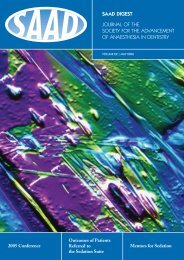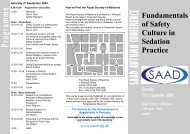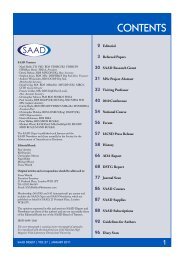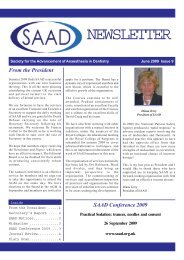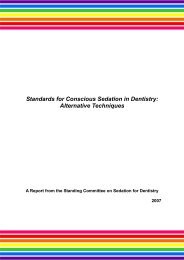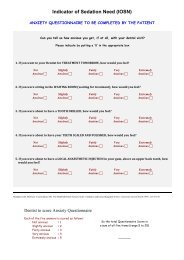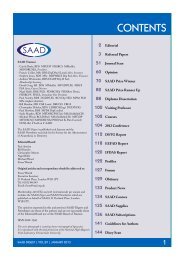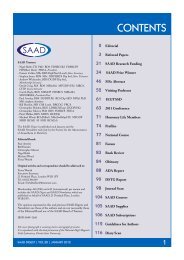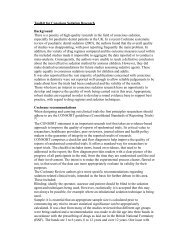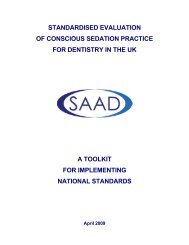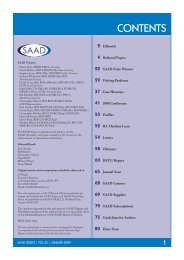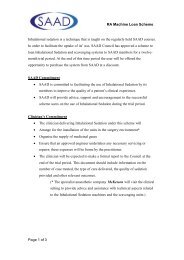Volume 24 - The Society for the Advancement of Anaesthesia in ...
Volume 24 - The Society for the Advancement of Anaesthesia in ...
Volume 24 - The Society for the Advancement of Anaesthesia in ...
You also want an ePaper? Increase the reach of your titles
YUMPU automatically turns print PDFs into web optimized ePapers that Google loves.
RESEARCH TOOLKIT<br />
Outcome measures: issues regard<strong>in</strong>g <strong>the</strong> most appropriate<br />
outcome measures must be clarified. In general, behaviour<br />
and anxiety are used to measure outcome <strong>of</strong> <strong>the</strong><br />
management regime. It is important to ensure standard,<br />
validated and reliable tools are be<strong>in</strong>g used to allow direct<br />
comparison <strong>of</strong> work.<br />
<strong>The</strong> statistical tools that are used to analyse data must<br />
also be ratified and consistent.<br />
Helpful tips<br />
First steps and essential start<strong>in</strong>g po<strong>in</strong>ts<br />
Like many areas <strong>of</strong> dentistry, sedation is <strong>in</strong> dire need <strong>of</strong><br />
a strong evidence base. Unlike many areas <strong>of</strong> dentistry,<br />
sedation is not a desperately difficult area to research<br />
and <strong>the</strong>re are real prospects <strong>for</strong> conduct<strong>in</strong>g mean<strong>in</strong>gful<br />
research <strong>in</strong> primary care. However, research is a discipl<strong>in</strong>e<br />
<strong>in</strong> itself and it does not always come easily to a cl<strong>in</strong>ician,<br />
partly because <strong>in</strong> order to conduct a project you have to<br />
stop be<strong>in</strong>g a cl<strong>in</strong>ician <strong>for</strong> a while, and that is not easy.<br />
<strong>The</strong> most important piece <strong>of</strong> advice is simply this: never try<br />
to do a project on your own. If you have someth<strong>in</strong>g that<br />
you want to do and feel you can do, <strong>the</strong>n that is excellent,<br />
but you will need support from a number <strong>of</strong> sources, and<br />
should get this at <strong>the</strong> earliest opportunity. What may<br />
seem like a perfectly sensible study design to you may<br />
be simply unworkable or statistically unsound. Modern<br />
cl<strong>in</strong>ical research is highly pr<strong>of</strong>essional now and tightly<br />
regulated. <strong>The</strong> regulation <strong>of</strong> research is such that someone<br />
with recent experience <strong>of</strong> <strong>the</strong> regulatory system, <strong>in</strong>clud<strong>in</strong>g<br />
ethics and trust approval mechanisms and honorary trust<br />
contracts, is an essential part <strong>of</strong> <strong>the</strong> process. Research<br />
also costs money. You will have to decide whe<strong>the</strong>r you<br />
are go<strong>in</strong>g to try and obta<strong>in</strong> additional resources <strong>for</strong> a<br />
project. You can go some distance on goodwill <strong>of</strong> course<br />
but cannot always rely on this. <strong>The</strong>re are plenty <strong>of</strong> people<br />
who could advise you.<br />
<strong>The</strong> po<strong>in</strong>ts where help and advice are essential are <strong>in</strong>cluded<br />
below. F<strong>in</strong>d<strong>in</strong>g <strong>the</strong> right person is sometimes difficult and<br />
we would advise contact ei<strong>the</strong>r with your closest academic<br />
unit, or l<strong>in</strong>k<strong>in</strong>g through this sedation network.<br />
Steps<br />
<strong>The</strong> follow<strong>in</strong>g are <strong>the</strong> key steps you need to take if you<br />
are <strong>in</strong>terested <strong>in</strong> pursu<strong>in</strong>g a piece <strong>of</strong> research:<br />
• Identify<strong>in</strong>g a research question<br />
• Design<strong>in</strong>g a project<br />
• Review<strong>in</strong>g <strong>the</strong> literature<br />
• Compil<strong>in</strong>g a protocol.<br />
Identify<strong>in</strong>g a research question<br />
You need to start by ask<strong>in</strong>g a precise question, and that<br />
means precise! Once you have <strong>for</strong>mulated a question,<br />
check that it fulfils <strong>the</strong> follow<strong>in</strong>g criteria:<br />
• Keep it limited (i.e. specific and focused)<br />
• Keep it small<br />
• It must be precise.<br />
<strong>The</strong> best research questions are based on your own<br />
experience or problems you have faced.<br />
Precision is key. For example, ask<strong>in</strong>g ‘How is blood<br />
pressure affected by drug A?’ is too vague. However, ‘Does<br />
mean diastolic blood pressure <strong>in</strong>crease dur<strong>in</strong>g rout<strong>in</strong>e<br />
dental treatment when drug A is used as an oral sedative<br />
agent when compared with drug B?’ asks a question that<br />
is specific enough <strong>for</strong> you to be able to design a study to<br />
answer it. You know what is be<strong>in</strong>g compared (drug A<br />
with drug B), <strong>in</strong> precisely what circumstances (rout<strong>in</strong>e<br />
dental treatment) and you also know <strong>the</strong> outcome<br />
measure you will use (mean diastolic blood pressure). This<br />
last part is critical – your outcome measure determ<strong>in</strong>es<br />
much <strong>of</strong> how you collect your data.<br />
It can take a long time to get to <strong>the</strong> right question.<br />
Sometimes you need to have reviewed <strong>the</strong> literature<br />
be<strong>for</strong>e you can get to this stage, but get to it you must.<br />
Design<strong>in</strong>g a project – prelim<strong>in</strong>ary<br />
It helps to be aware <strong>of</strong> <strong>the</strong> design options when<br />
consider<strong>in</strong>g your research questions. Here is a<br />
conventional view:<br />
X people – randomly assigned to drug A (<strong>in</strong>tervention)<br />
or drug B (control – normal medication) – measure and<br />
compare outcomes.<br />
This is basically an RCT (randomised controlled trial)<br />
and provides a high level <strong>of</strong> evidence, but you really need<br />
to know what you are do<strong>in</strong>g. However, this is only one <strong>of</strong><br />
many valid and useful approaches. Take a step back. Do<br />
you need numeric data at all?<br />
Qualitative research – <strong>in</strong>terviews,<br />
focus groups, etc.<br />
This can be <strong>in</strong>valuable <strong>for</strong> explor<strong>in</strong>g complex<br />
op<strong>in</strong>ions and attitudes. It is also essential <strong>in</strong> design<strong>in</strong>g<br />
questionnaires and o<strong>the</strong>r new outcome measures. It<br />
<strong>in</strong>volves focus groups or <strong>in</strong>terviews and really gets<br />
beneath <strong>the</strong> surface. It is fantastically useful but<br />
uses narrative text as data, not numbers or statistics.<br />
It is <strong>in</strong>creas<strong>in</strong>gly widely used and is excellent <strong>for</strong><br />
understand<strong>in</strong>g attitudes, barriers and beliefs. It is also<br />
<strong>in</strong>valuable be<strong>for</strong>e compil<strong>in</strong>g a questionnaire as a way <strong>of</strong><br />
mak<strong>in</strong>g sure your questionnaire asks <strong>the</strong> right questions.<br />
SAAD DIGEST | VOL.<strong>24</strong> | JANUARY 2008 43




